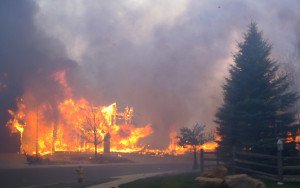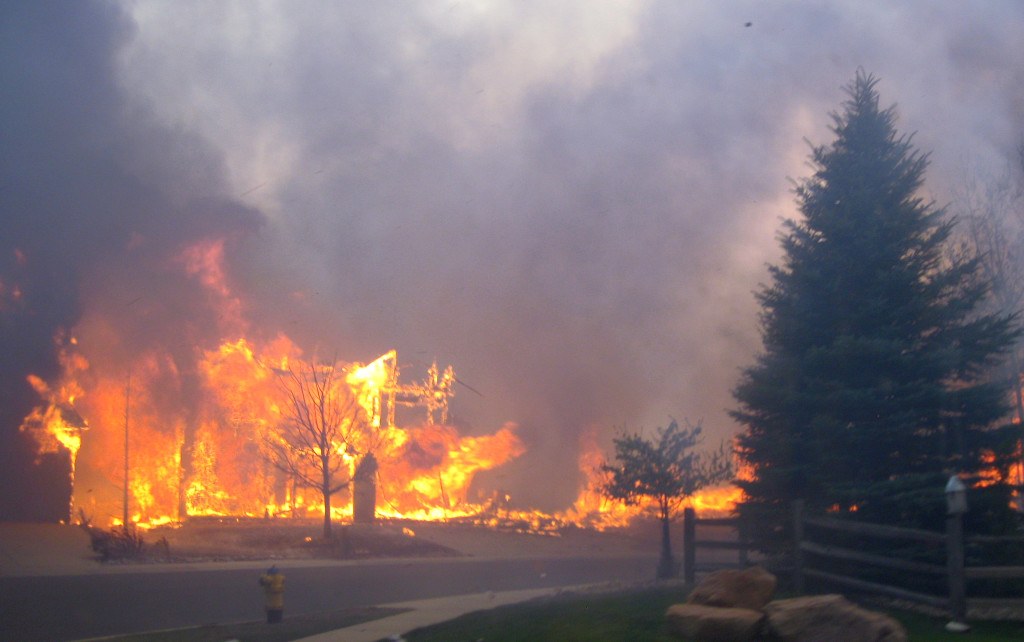A new study of Colorado’s devastating 2012 Waldo Canyon wildfire demonstrates that prompt and effective action can significantly change the outcome of fires that occur in areas where residential communities and undeveloped wildlands meet. The study by the U.S. Department of Commerce’s National Institute of Standards and Technology (NIST) is the most comprehensive examination in history of a wildland urban interface (WUI) fire.
“WUI fires are very different from earthquakes, hurricanes and tornados where the hazard cannot be controlled,” said NIST fire researcher and principal investigator Alexander Maranghides. “Our study showed that WUI fires also are distinct from either urban or wildland fires alone. We provide strong evidence that defensive measures designed specifically for the wildland urban interface and administered early can significantly reduce destruction and damage.”

For example, the study found that because the Waldo firefighters tailored their response to the specific WUI conditions, 75 percent of their attempts to extinguish ignited structures were successful and 79 percent of their efforts at fire containment were successful in preventing rampant fire spread.
The details of the NIST study are described in a report released during the Fire Chiefs White House Roundtable on Climate Change Impacts at the Wildland Urban Interface.
The number of WUI fires, particularly in the western and southern regions of the United States, has grown as housing developments push into wilderness areas. According to the Bureau of Land Management’s National Interagency Fire Center (NIFC), the 10 years since 2002 saw an annual average of nearly 71,000 WUI fires recorded and 1.9 million hectares (4.7 million acres) burned. Today, more than 32 percent of U.S. housing units and one-tenth of all land with housing are situated in the nation’s 89 million hectares (220 million acres) of WUI, putting approximately 72,000 communities and more than 120 million people at risk.
The physical and monetary toll from WUI fire destruction is staggering. The NIFC calculates that nearly 39,000 homes—more than 3,000 per year—were lost to wildfires from 2000-2012 and that federal, state and local agencies spent an average of $4.7 billion annually during that period on WUI fire suppression.
The Waldo Canyon WUI fire started on June 23, 2012, just southwest of Colorado Springs, Colo. By the time the blaze was declared contained on July 10, 2012, it left two people dead, destroyed 344 homes and damaged more than 100, burned 7,384 hectares (18,247 acres) and cost an estimated $454 million in insured losses.
The NIST study, conducted in collaboration with the U.S. Department of Agriculture’s U.S. Forest Service (USFS) and the federal Joint Fire Science Program, documented and assessed the chronology, behavior and outcomes of the fire, as well the firefighting activity against it.
In their investigation, Maranghides and his colleagues focused on the Mountain Shadows community in Colorado Springs, the location for all of the homes destroyed in the Waldo Canyon fire. The scientific analysis of the fire’s impact on Mountain Shadows and the effectiveness of defensive measures taken to suppress it took two years to complete. Researchers spent 4,500 hours on data collection, conducted more than 200 technical discussions with first responders and made more than 4,500 distinct fire and defensive action observations.
Along with the most detailed timeline for a WUI fire ever created, the Waldo Canyon investigation yielded 37 technical findings that served as the basis for 13 technical recommendations aimed at improving community resilience to wildfires.
Among the key findings:
- WUI fire dynamics change rapidly and require special consideration. “For example, if your home is nestled deep within a neighborhood away from the leading edge of a fire, you might not be at risk early on,” Maranghides said. “However, the danger to your home dramatically increases if a neighboring house, the surrounding landscape or a nearby vehicle catches on fire.”
- WUI fires create “cascading ignitions.” The intensity, spread and destructive power of a WUI fire increases rapidly as more and more structures are ignited. In the Waldo Canyon fire study, the researchers found that only 48 of the destroyed homes were ignited directly from the wildfire. Structure-to-structure spread from these early ignitions resulted in the cascading ignition of the other 296 destroyed homes.
- Defensive measures were very effective in suppressing burning structures and containing the Waldo Canyon fire because they took WUI conditions into account. First responders were able to contain fire spread or “box in” much of the fire because they effectively assessed fire behavior, exposure risks to structures from fire and embers, and potential responses by structures to the changing conditions.
- There was not a nationally accepted system available for pre-planning the response to the Waldo Canyon event. Although firefighter response to the fire was effective, the researchers believe that pre-fire planning could have further enhanced the effort. Unfortunately, there currently is not a nationally accepted system on how to do preplanning for WUI fires. Such planning requires an intimate understanding of exposure risks and vulnerabilities—both for individual structures and the community as a whole. To help first responders and others to gain this understanding, NIST is developing both an in-the-field, two-tiered system for collecting data after WUI fires and a WUI Hazard Scale for predicting and mapping the ranges of exposure risks to fire and embers from a WUI event throughout a community.
Among the key technical recommendations:
- Fire departments should develop, plan, train and practice standard operating procedures for responding to WUI fires in their specific communities. These procedures should result from scientifically mapping a community’s high- and low-risk areas of exposure to both the fire and embers generated during WUI events (as will be possible using the WUI Hazard Scale).
- A “response time threshold” for WUI fires should be established for each community. Fire departments have optimal “time-to-response” standards for reaching urban fires. Similar thresholds can, and should be, set for WUI fires.
- High-density structure-to-structure spacing in a community should be identified and considered in WUI fire response plans. In the Waldo Canyon fire, the majority of homes destroyed were ignited by fire and embers coming from other nearby residences already on fire. Based on this observation, the researchers concluded that structure spatial arrangements in a community must be a major consideration when planning for WUI fires.
NIST’s work on WUI fires is part of its ongoing programs for enhancing disaster resilience by reducing the risks of fires, earthquakes, windstorms and coastal inundation on buildings, infrastructure and communities, including facility occupants/users and emergency responders.
Source: NIST
Was this article valuable?
Here are more articles you may enjoy.


 UBS Client Can’t Sue Bank Over Broker’s Alleged Affair With Wife
UBS Client Can’t Sue Bank Over Broker’s Alleged Affair With Wife  Hackers Abuse Modified Salesforce App for Data Theft and Extortion, Google Says
Hackers Abuse Modified Salesforce App for Data Theft and Extortion, Google Says  Fixing the Claims Experience Where It Matters Most: In the Mess
Fixing the Claims Experience Where It Matters Most: In the Mess  We Have Entered A New Era of Auto Claims Complexity
We Have Entered A New Era of Auto Claims Complexity 